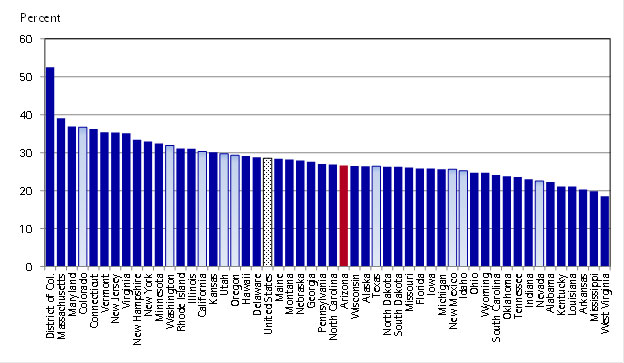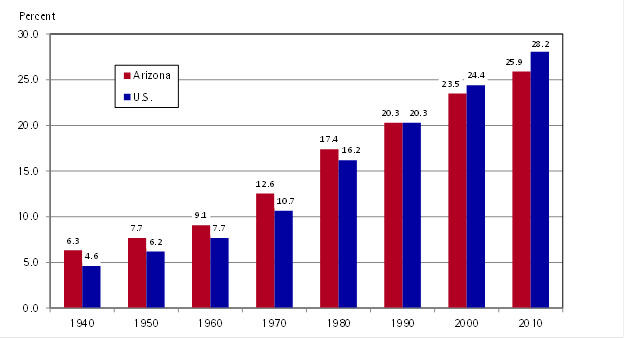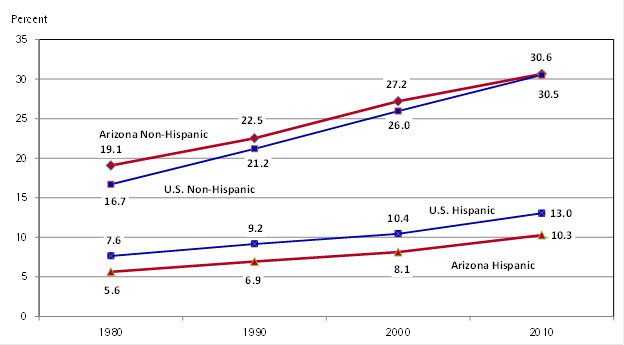By George W.Hammond, Ph.D.
EBR Associate Director and Eller Research Professor
September 15, 2013
Education is a crucial determinant of long-run income growth. This assertion seems obviously true for individuals, where increases in education lead to higher salaries over time. However, something similar is also true for nations, states, counties, metropolitan areas, and nonmetropolitan areas i.
High concentrations of highly educated residents in a region, particularly those with a Bachelor’s degree or better, leads to stronger income growth in the region in the long run. Further, it is not just highly educated workers that benefit. Less educated workers also earn more in cities with high concentrations of the highly educated.
Thus, the college attainment rate is one critical determinant of Arizona’s economic success. Unfortunately, while the state rate has risen rapidly during the past 70 years, its growth has not kept pace with the nation. In fact, Arizona’s college attainment rate was below the national level in 2011.
This article provides Arizona’s Economy readers with a short summary of results from a new EBR study “Troubling Trends in Arizona’s College Attainment.” The longer study presents detailed evidence on Arizona’s college attainment trends during the past 70 years, including trends for counties and metropolitan areas.
The U.S. Census Bureau estimated that there were 1,119,198 Arizona residents age 25 and older with a bachelor’s degree or better in 2011. That translated into a college attainment rate of 26.6%, which was 1.9 percentage points below the national average of 28.5%, and ranked the state 27th in the nation. As Exhibit 1 shows, Arizona’s college attainment rate was well below that of several western states, including Colorado, Washington, California, Utah, and Oregon. Nevada, Idaho, New Mexico, and Texas posted lower college attainment rates than Arizona in 2011.

Exhibit 1: U.S. State College Attainment Rates in 2011
Percent of the Population Age 25 and Older with a Bachelor’s Degree or More
Source: U.S. Bureau of the Census
The state has gradually lost ground to the nation during the past 70 years. As Exhibit 2 shows, Arizona’s lead gradually declined during the five decades from 1940 to 1990 when the state and national rates were equal at 20.3%. During the next 20 years, the state gradually fell further behind the nation. In 2010, the national college attainment rate hit 28.2%, compared to 25.9% for Arizona, which ranked the state ranked 32nd in the U.S. To sum up, during the 70 year period beginning in 1940, Arizona’s college attainment rank fell from 4th in the nation to 32nd. Arizona has lost ground on a crucial competitive dimension.

Exhibit 2: Arizona and U.S. College Attainment Rates
Percent of the Population Age 25 and Older
Four or More Years of College: 1940-1980
Bachelor’s Degree or More: 1990-2010
The Arizona college attainment rate grew less rapidly than the nation from 1980 to 2010, at 48.7% compared to 73.7% for the U.S. In part, this was related to strong growth in the Hispanic population in Arizona, whose population share (age 25 and older) rose from 12.4% in 1980 to 23.3% in 2010. The national Hispanic population share (age 25 and older) also rose rapidly, from 5.1% to 13.4% during the same period. Exhibit 3 shows college attainment rates for both Hispanic and Non-Hispanic residents from 1980 to 2010. Growth in the Hispanic population share tended to slow gains in college attainment because the Hispanic college attainment rate was lower than the rate for Non-Hispanics, both nationally and in the state, and because the Hispanic college attainment rate in Arizona was lower than the nation ii.
Exhibit 3: Hispanic and Non-Hispanic College Attainment Rates Population Age 25 and Older
Another factor contributing to slow growth in Arizona’s college attainment was the relatively slow growth in the Non-Hispanic college attainment rate. Indeed, if in 2010 Arizona had exactly the same Hispanic population share and Hispanic college attainment rate as the nation, the state rate would be essentially equal to the national rate.
It is important that Arizona not fall behind in the race to build human capital. There is evidence that metropolitan areas that began with higher levels of college attainment were able to attract more college graduates during the ensuing decades than were regions that started with fewer college graduates. This sets the stage for increasing geographic inequality in human capital and ultimately in income iii.
Raising Arizona’s college attainment rate will contribute to more rapid income growth. For instance, the Milkin Institute (DeVol, Shen, Bedroussian and Zhang, 2013) has recently estimated that adding one extra year to the average years of schooling of the employed in a metropolitan area can increase real GDP per capita by 10.5% and real wages per worker by 8.4%. Further, Hoffman and Rex (2012) concluded that increasing the state’s educational attainment, particularly for younger workers, would have significant positive impacts on state income.
However, increasing Arizona’s college attainment rate will not be straight forward. There is no silver bullet solution to the problem. More research is needed to determine which approaches might yield the best results. This research should focus on policies that will strengthen both the supply of and demand for college graduates. On the supply side, the state needs to improve education outcomes and strive to improve access to higher education. Strengthening PK-12 education will increase the overall quality of the workforce and improve the performance of local students enrolling in college. Then the higher education system can focus on generating high quality college graduates and world-class research, as well as service to the state. The multifaceted contribution of the universities and colleges is a key part of their role in an ecosystem that generates job growth for college-educated workers iv.
But this cannot be the only response, since education also increases worker mobility. Thus, college graduates will leave the state if there are not enough job opportunities locally. State policymakers need to focus on building a diversified industry and employment mix that generates ample employment opportunities for Arizona college graduates, as well as those with lower levels of attainment. No state has this completely figured out yet, but local leaders around the country are increasingly aware that whoever wins the battle to attract college graduates will also win the battle for improved income growth and standards of living.
Footnotes:
i For examples: see Barro and Sala-i-Martin (1999) for nations; Bauer, Schweitzer, and Shane (2012) for states; Higgins, Levy, and Young (2006) for counties; Glaeser and Saiz (2004) for metropolitan areas; and Hammond and Thompson (2008) for nonmetropolitan areas.
ii See Hart and Hager (2012) for an in-depth analysis of these issues.
iii For more on this point see Glaeser and Berry (2005), Hammond and Thompson (2010), and Moretti (2012).
iv For more on these issues, see Goldin and Katz (2008).
References:
Bauer, Paul W., Mark E. Schweitzer, and Scott A. Shane. 2012. “Knowledge Matters: The Long-Run Determinants of State Income Growth,” Journal of Regional Science, 52(2), 240-255.
Barro, Robert J. and Xavier Sala-i-Martin. 1995. Economic Growth. Cambridge: MIT Press.
DeVol, Ross C., I-Ling Shen, Armen Bedroussian, and Nan Zhang. 2013. “A Matter of Degrees,” Milken Institute.
Glaeser, Edward L. and Christopher R. Berry. 2005. “The Divergence of Human Capital Levels Across Cities,” Papers in Regional Science, 84(3), 407-444.
Glaeser, Edward L. and Albert Saiz. 2004. “The Rise of the Skilled City,” Brookings-Wharton Papers on Urban Affairs, 5, 47–94.
Goldin, Claudia and Lawrence F. Katz. 2008. The Race Between Education and Technology. Cambridge: Harvard University Press.
Hammond, George W. and Eric C. Thompson. 2010. “Divergence and Mobility in College Attainment Across U.S. Labor Market Areas: 1970-2000,” International Regional Science Review, 33(4), 397-420.
Hammond, George W. and Eric C. Thompson. 2008. “Determinants of Income Growth in Metropolitan and Nonmetropolitan Labor Markets,” American Journal of Agricultural Economics, 90(3), 783-793.
Hart, Bill and C.J. Eisenbarth Hager. 2012. “Dropped? Latino Education and Arizona’s Economic Future,” Morrison Institute for Public Policy, April 2012.
Higgins, Matthew J., Daniel Levy, and Andrew T. Young. 2006. “Growth and Convergence Across the U.S.: Evidence from County-Level Data,” Review of Economics and Statistics, 88(4), 671–681.
Hoffman, Dennis and Tom R. Rex. 2012. “Benefits from Improving Educational Attainment in Arizona,” Productivity and Prosperity Project, W.P. Carey School of Business, Arizona State University.
Moretti, Enrico. 2012. The New Geography of Jobs. New York: Houghton Mifflin Harcourt.






